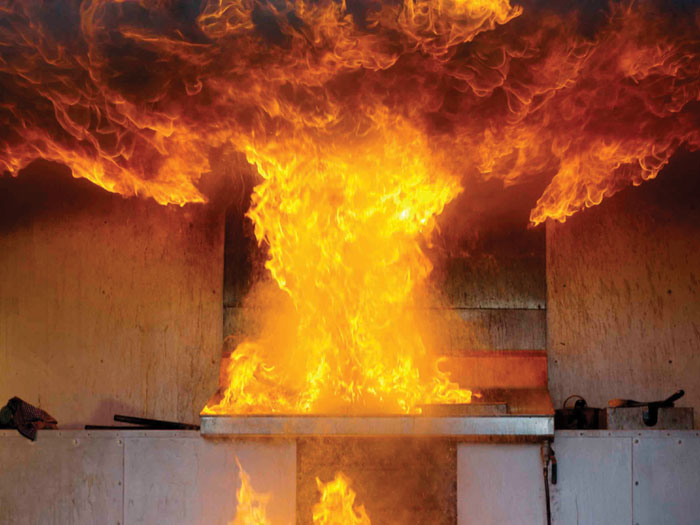Risk Scenario
An Explosive Claim
Disclaimer: The events depicted in this scenario are fictitious. Any similarity to any corporation or person, living or dead, is merely coincidental.
Part One
Dan Mueller sighed and poured himself an iced tumbler of Old Buzzard bourbon and water.

The long-time risk manager for the Turkee Jerkee snack factory in Monongahela, a small town southeast of Pittsburgh, had just gotten back from a trip to see his underwriters in Boston, New York and Chicago.
From the deck that overlooked his backyard, he could see the small circles as trout kissed the surface of the Youghiogheny River, sucking in the last midges of autumn as they drifted among the fallen leaves. He was grateful to be back in his home in Northern Appalachia.
“You can have the big cities,” he thought to himself. “I’ll take this any day.”
At his side during those renewals was Joe Turnbull, a regional vice president for one of the largest brokerages in the country. Joe had been Dan’s risk management partner for the past 30 years.
Joe and Dan were long-time golfing buddies and served on the board of the Elizabeth Country Club: From Dan’s perspective, they made a good business team. They were from the same generation and did things the same way: Old school was good school in their view.
Their record keeping was old school too. No fancy software programs for them. They knew how to read a policy and where to find one when they needed it, in their filing cabinets where they had always been.
The property/casualty insurance program they had put together for the Turkee Jerkee plant in 1981 had remained pretty much unchanged in recent years, except for some increases in limits and the addition of new carriers, as the business grew past the $5 million in annual revenue threshold. Joe assured Dan the language in the new carriers’ policies matched up well with the existing language, they had no gaps in coverage to worry about.
The Turkee Jerkee plant had a good safety record and the company’s 2012 property/casualty renewals had resulted in small decreases in premium on the key elements of their coverage, their all-risk property coverage and their comprehensive general liability coverage.
That was the way Dan Mueller’s work world looked as he drank his bourbon.
Five months later, Dan heard the sirens of the local volunteer firefighting companies spring to life in the early morning hours. His neighbor was a volunteer fireman, and Dan looked out his drive to see him run to his SUV, flip on his blue volunteer firefighter’s cab light and speed off into the darkness.
Dan didn’t know that it was his company that his neighbor was trying to save. That knowledge came in the form of a phone call 20 minutes later from the company’s vice president of administration.
“There’s been an explosion at the plant, we need you here immediately!” she said, fighting to make herself heard against the cacophony of the firefighter’s sirens in the background.
When Dan reached the plant, the vice president told him that three of the overnight maintenance crew had been killed instantly by an explosion which had ripped out the back end of the facility. Two other workers, both with more than 20 years on the job, had been life-flighted to the James R. Reynolds Memorial Hospital in Greensburg with second and third degree burns over more than half of their bodies.
Complicating matters, she said, was that the neighboring water treatment plant had suffered significant damage.
Eric Fierstone, the company’s CFO, was huddled with the son of the company founder in the shadows cast by emergency response vehicle spotlights.
“The whole back of the plant is gone,” Eric told Dan, who at this point was slack-jawed with shock.
“Both production lines were hit,” Eric said. “I don’t know when we come back from this,” he said.
Eric hadn’t meant it that way, but the news of his co-workers deaths, and that last sentence in particular, hit Dan hard. It was Dan’s job to make sure that insurance payments got the plant back up as soon as possible. So he had better get started doing his job.
Dan called Joe Turnbull but the call went to straight to voicemail.
“Damn it Joe, wake up,” Dan said.
As Dan waited for Joe to respond, he did more mental sifting. He had a $9 million primary layer on his property all-risk and another $5 million when he looked at his excess layers.
General liability and employers’ liability combined was $15 million with a $10 million excess layer.
There were endorsements on the primary and excess property layers that should cover the damage to the water treatment plant.
“Might just make it,” he thought.
He hated to think that way with three people dead, but that was doing his job too.
Part Two

Even six months after the accident, Dan was still receiving floods of calls and emails.
Many of those were from plaintiffs’ attorneys who had been swamping him with information requests. Adding to the influx of calls was the fact that the carriers on his property program, Apex Inc., Vitality Assurance and Stonehenge, couldn’t agree on who was covering what. Making matters worse was the fact that each had its own adjustor, and none of them were seeing eye to eye.
Dan and Joe were going as fast as they could, working through file after file of paperwork to try to reconcile the language in each policy, but the process was incredibly time consuming and several important files had been lost or damaged when fire sprinklers kicked on after the explosion. The only time Dan had used his fishing waders since the accident was to wade through his office in the effort to save what he could.
Dan had always felt he had a good system for managing his policies, but with time at a premium, he was finding that carriers and attorneys used to almost instant responses on requests for data didn’t have a whole lot of patience with his process or his efforts to piece together lost or damaged files.
The further he and Joe fell behind, the more they got badgered. Dan was sure he had the information that everyone needed. He just couldn’t get to it fast enough to please anyone.
An investigation by the Westmoreland County fire inspector determined that Turkee Jerkee workers installing a new meat refrigeration unit had failed to monitor the escaped gas that was building up as they switched out new gas lines for old ones. The levels of gas soon reached the point where they were ignited by a pilot light on one of the factory’s heated saline curing vats.
The damage to the building was extensive and estimates were that it could be 18 months until the plant was back up again. Dan knew that he had 12 months business interruption coverage and a three-month add-on for extended liability. One of his worst worries was that he might not have enough payroll coverage as part of his business interruption coverage under his property policy.
When he and Joe had first bound the coverage, back in the early 1980s, skilled manufacturing labor in Western Pennsylvania as plentiful and what they had arranged for then had seemed like plenty. If they lost employees then, there were plenty of skilled technicians in the job pool to replace them.
But manufacturing, and the labor market in manufacturing, had changed drastically over the years. It was now looking like the coverage they had was not nearly enough to keep the company’s skilled workers from jumping ship.
That’s exactly what Eric Fierstone, CFO, wanted to talk about when he called Dan Mueller into his office that November morning.
“Have you talked to Apex lately?” Eric said in a challenging tone as Dan sat down.
“Yes I have. They’re looking for data on our payroll projections as part of the business interruption coverage,” Dan said.
“Well…?” Eric said.
“I…we don’t have it yet,” Dan said. “The broker and I are trying to dig out the numbers, but it’s taking a while,” Dan said.
“Why is it taking so long?” Eric said.
“We have a ton of policies and reports to sift through and we just need more time,” Dan said.
“I don’t think we have all that much more time,” Eric said.
Part Three
It was a few weeks later when “The Call” came.
“Dan, it’s me,” Joe said, and right away Dan knew it wasn’t good.

“What is it?” Dan said.
“Vitality is claiming the property endorsement that picks up the water plant isn’t there in the renewal language on the excess layer.”
“You can’t be serious! Did you read it?”
“I don’t have a copy of it, do you?” Joe said.
Dan felt a current of irritation run through him.
“How could you not have the policy?”
Joe didn’t say anything.
“I’ll look at it tonight. I’m pretty sure it’s in there,” Dan said.
“They say it’s not. They say in the renewal the plant was covered for an act of God but not our plant operator error,” Joe said.
“I can’t believe it,” Dan said.
“Anything else?”
“Vitality, Apex and Stonehenge aren’t any closer on the coverage language in their policies,” Joe said. “Their adjustors could be months doing this,” he said.
“There’s no way I’m going to have enough payroll coverage now,” Dan said.
“It doesn’t look like it. Not unless you want to try and take the carriers to court and that certainly won’t help our timeline,” Joe said.
“Alright,” Dan said. “I’m going to hang up and see if I can locate that excess property endorsement language.”
As things stood, the company would lose substantial market share if it couldn’t get up and running soon, and with the carriers not agreeing on some elements of coverage, not opening soon enough was looking like a real possibility. Then there was the issue of some of the damage to the neighboring water treatment plant going without reimbursement.
On the one hand, the certain loss of crucial market share. On the other, a probable lawsuit from the Youghiogheny Water and Sewer Authority.
Dan turned away from his desk and looked at his filing cabinet. He had bought the thing from a second-hand office furniture place off of The Boulevard of the Allies in Pittsburgh. It was an ugly, military green and weighed a ton, but it had always held a special place in his heart.
He stuck his “Trout Unlimited” member stickers on it and it was where he put his magnetic calendar of the Pittsburgh Pirates’ schedule of games.
It was his fortress, where he kept the years and years of policies the management of which was his profession.
Now, what he had thought of as a fortress contained a puzzle that he couldn’t solve. He didn’t have a system to see what he needed to see in his policies in the time he needed to.
The carriers had run off without him and were having their own battle now. And now there was this gap in coverage due to disputed language in an endorsement that had blown probably a $500,000 hole in things, minimum.
Dan knew in his heart that the executive at Vitality could read English and that the gap was there. He and Joe just hadn’t picked it up at renewals and didn’t have a system that could back them up.
Dan Mueller was the only person in the company at this point that knew for sure that the gap existed. Tomorrow Eric Fierstone and the rest would know.
Dan didn’t even want to think about how that conversation would sound. Without looking out to the river he so loved, Dan poured himself three fingers of Old Buzzard and drank two-thirds of it at a gulp.
Maybe it was the burn of the whiskey, but tears came to his eyes.
Summary
What was already a tragic event ends up spelling even deeper trouble for Dan Mueller, the risk manager of the Turkee Jerkee manufacturing facility in Western Pennsylvania, when a factory explosion reveals the coverage gaps in his program and the lack of transparency he had in his understanding the company’s policy terms and endorsements.
1. Establish a single adjustor: In the case of the Turkee Jerkee factory explosion, an insurance program that had grown and added carriers over the years failed to establish language that would confirm the use of a single adjustor acceptable to all of the carriers on the expanded program. If a single adjustor had been established pre-loss, valuable time could have been saved and not frittered away in coverage disputes between carriers.
2. Conduct broker peer reviews: The Turkee Jerkee risk manager, Dan Mueller had a longstanding relationship with a trusted broker, Joe Turnbull. But Joe dropped the ball by not seeing to it that a property endorsement insuring a neighboring facility would be triggered in the case of operator error. If Dan had not had such a cozy relationship with Joe and had asked for a peer review of Joe’s work, this situation could have been avoided and the business possibly saved.
3. Utilize effective policy management systems and software: When it comes to a business interruption claim, time is of the essence. The lack of transparency that Dan Mueller had into the language of the various policies that represented his program cost him valuable time. Had he been able to put his hands on key sections of his coverage sooner, he could have saved himself time and avoided losing substantial market share due to an extended business interruption. This doesn’t end with simply buying a program. It’s an ongoing, hands-on monitoring job.
4. Arrange meaningful extended liability coverage: Dan Mueller’s company faced the loss of key employees because the Turkee Jerkee company lacked adequate coverage for payroll expenses under the extended liability coverage that was tacked on to its business interruption policy. If key, skilled employees jump ship due to payroll shortfalls, the company still faces substantial loss of market share due to diminished manufacturing capacity even after it uses insurance payments to get up and running.
5. Purchase insurance for worst-case scenarios: Risk managers can fall into the trap of buying insurance for what they believe will be the loss as opposed to what the worst-case loss could be for any given product line.












